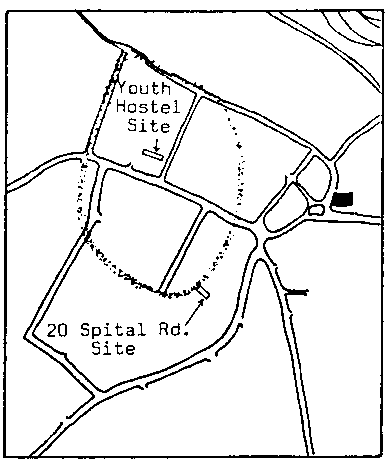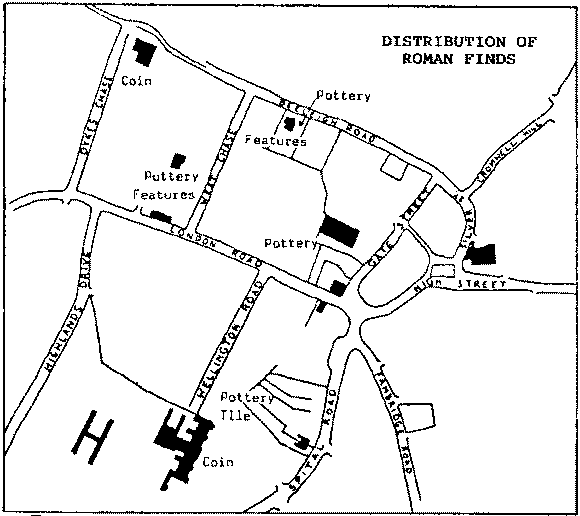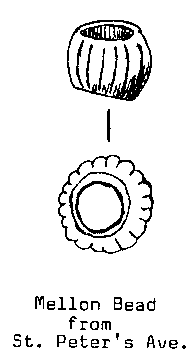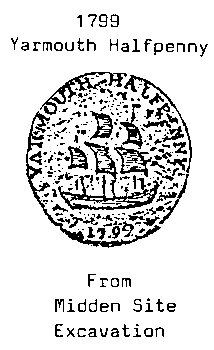
|
|
|
Comment
Both the Youth Hostel and 20 Spital Road sites have produced a significant quantity of residual early Iron Age pottery sherds. This evidence from two small excavations over 60 metres apart is surely proof of intensive occupation on the hilltop at this time. The reluctance by some experts to accept Maldon as an early Iron Age hillfort is largely due to the complication of the Late Saxon activity. Had Maldon not been mentioned in the Chronicles we would find it already on the list of Essex hillforts. The earliest phases of the 20 Spital Road ditch probably date to this period but ironically did not produce the pottery evidence so common in later layers, (See jigsaw piece 15 - 20 Spital Road). |

|

|
ROMAN EVIDENCE |

|

|
|
Two of the excavations within our 'burh' area have produced Roman features i.e. the Youth Hostel site and 33 Beeleigh Road. Maldon Archaeological Group has also found residual Roman pottery and tile from other sites at the 'top' end of the town. Several coins have come to light and have been recorded in histories of Maldon. Recently a Roman necklace bead has been found in a rear garden at the top of St. Peters Avenue not far from the burh area. Comment The Romans would have been quick to notice the strategic importance of the Maldon hilltop. Not only did it command the mouth of an important river system it also overlooked the port at Heybridge. Before the Claudian invasion, Heybridge had already become an important trade centre and contact with the Roman world. Being so close to the then British capital at Colchester, it is quite feasible that Maldon played a part in the defeat of the British in AD 43. Later, especially after Boudicca's revolt in AD 61, the Roman authorities would not wish Maldon's commanding hilltop position to fall into enemy hands and would therefore maintain some sort presence as a deterrent. |

|
|

|
G. HANGER - Reflections on the menace of invasion and a means of protecting the capital (London) by preventing the enemy from landing and a correct military description of Essex and Kent. – 1795
......... From the great attention which has been paid to the defence of the
Thames, and particularly to the defence of the Hope, I trust, my Lord, we are
in no danger from that quarter. Supposing that point safe, I think, my Lord,
there is but one other place where the enemy can ever land any strong body of
troops, contiguous to the capital, in Essex: I speak not of the neighbourhood
of Harwich, for I call that not contiguous to the capital, as it is 73 miles
distant; the spot I mean to point out is within 38 lies of London; it is the
Blackwater river on which Maldon in Essex is situated. I believe (but will not
assert) there is no defence whatever made to this river, yet it must be
acknowledged that a numerous body of troops are near at hand. It might be
defended very easily, and at small expends, by throwing up a few redoubts, so
strong as not to be taken by assault .......................
|
|
Comment
The observations of a militarily minded man nearly two centuries ago serve to
remind us of the areas strategic importance. Hanger tells us that his survey,
including Essex and Kent, took four years to complete and because of a lack of
confidence in Maps he insisted on investigating all locations personally. His
Military criteria would have been more akin to the ancients than ours in the
1980s.
Evidence for this period is surprisingly difficult to pin down. Two buildings which are believed to relate to the barracks are both inside the burh area but we do not know if use was made of the earthwork remains as a defence for the resident troops. A thick layer of Soil over the 20 Spital Road site could represent an effort to reinforce the ancient earth bank. The large number of military burials recorded in church registers, mostly St. Peters, emphasises the soldiers miserable disease ridden conditions, which were particularly bad in Maldon. More details of these burials can be found in the Group's St. Peter's ecclesiastical interim report. |

|
|

|

|